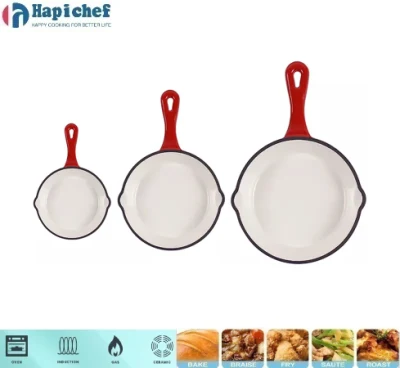Heavy Cast Iron Cookware Manufacturing Facility Offering Quality and Durability in Every Product
The Craftsmanship of Heavy Cast Iron Pan Manufacturing
Heavy cast iron pans are a staple in kitchens around the world, prized for their durability, heat retention, and versatility. The process of manufacturing these pans is a testament to traditional craftsmanship combined with modern technology, creating a product that not only cooks food to perfection but also stands the test of time.
At the heart of cast iron pan production is the material itself. The process begins with selecting high-quality pig iron, which serves as the primary component. This iron is melted in an induction furnace, where precision temperature controls ensure that it reaches exactly the right consistency. The melting process is crucial, as it determines the pan’s ultimate strength and cooking performance. The molten iron is then poured into sand molds, which are designed for specific pan shapes and sizes. These molds are made from a mixture of fine sand and clay, providing the necessary structure to withstand the weight and heat of the molten metal.
The Craftsmanship of Heavy Cast Iron Pan Manufacturing
Following fettling, the pans are subjected to an extensive cleaning process. This usually involves sandblasting to remove sand residues and any remaining oxides. The inherent porosity of cast iron necessitates this thorough cleansing, as any remnants can negatively impact the seasoning process.
heavy cast iron pan factory

Seasoning is one of the most vital steps in creating a heavy cast iron pan. This process involves applying a layer of oil to the cooking surface and heating it to create a natural non-stick coating through polymerization. The seasoning not only enhances the pan's cooking capabilities but also protects it from rust and corrosion. Skilled artisans may season the pans multiple times to ensure a robust and lasting finish.
Post-seasoning, the pans undergo quality control inspections. This step is crucial to maintain the high standards expected from heavy cast iron cookware. Each pan is scrutinized for imperfections, thickness, and overall craftsmanship. Defective items may be recycled, emphasizing the factory’s commitment to sustainability and quality.
Once they pass inspection, the pans are packaged for distribution. This is where branding plays a significant role. Many manufacturers emphasize the heritage and artisan aspects of their pans, appealing to both traditionalists and modern cooks alike. Heavy cast iron pans have become more than just cooking tools; they symbolize durability and culinary artistry.
In recent years, the popularity of cast iron cookware has skyrocketed, with many consumers leaning towards sustainable and long-lasting products. This trend has encouraged factories to innovate while respecting traditional production methods. Some facilities are exploring eco-friendly materials and processes, integrating technology that reduces energy consumption and waste.
The heavy cast iron pan factory is thus a unique blend of age-old traditions and modern advancements. Each pan produced is not just a tool but a piece of art created through meticulous craftsmanship. As households continue to cherish these versatile cooking instruments, the legacy of heavy cast iron cookware is likely to endure for generations, reflecting both history and innovation in every meal prepared.
-
hapichefs-casserole-cast-iron-cookware-symphonyNewsAug.23,2025
-
casserole-cast-iron-cookware-in-a-modern-art-installationNewsAug.23,2025
-
hapichefs-molten-artistry-portable-cast-iron-bbq-grill-birthNewsAug.23,2025
-
forging-flavor-in-acast-iron-bbq-grills-fireNewsAug.23,2025
-
hapichefs-enameled-cast-iron-bakeware-a-chefs-museNewsAug.23,2025
-
why-colorful-enameled-cast-iron-bakeware-improves-meal-tasteNewsAug.23,2025
-
Unleash Your Culinary Creativity with Specialized Roasting and Baking PansNewsAug.20,2025
